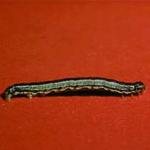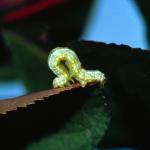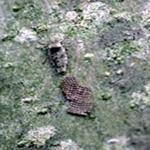Spring Cankerworm
Order: Lepidoptera
Family: Geometridae
Paleacrita vernata
Overview
Spring cankerworm (Paleacrita vernata) is a native pest of hardwood trees in North America. It overwinters as a pupa in the soil, emerges as an adult in the early spring (thus the name spring cankerworm), and the adults mate, and females lay eggs shortly thereafter. The eggs hatch that same spring and larvae feed on the leaves of their host plants. Hosts include apple, ash, beech, elm, hickory, linden, maples and oaks. Spring cankerworms do not often require active management; natural factors keep population levels below action or aesthetic thresholds. However, if a rare outbreak does occur, there are several ways to reduce spring cankerworm populations.
Host Plants
As noted above, spring cankerworm will subsist on any hardwood tree, but generally prefers apple, ash, beech, elm, hickory, linden, maples and oaks. A stand of one or all types of these trees close together would be particularly attractive to spring cankerworms.
Identification/Life Cycle
There is one generation of spring cankerworm per year. Spring cankerworms overwinter as pupae in cocoons in the soil. In the early spring (late February-March) when temperatures allow, they emerge from the cocoons as adult moths. Females are wingless, with a dark stripe on their back overlaying a brown-gray body. Males have light brown wings with three indistinct winding dark brown stripes crossing them. After mating, females crawl up a host tree and lay irregular egg masses in the upper branches, often inside a protected crevice in the bark. Eggs are tiny, oval, and laid in masses of approximately 50. Eggs hatch around budbreak, and the larvae (immatures), which are also called caterpillars, inchworms, or loopers, begin feeding on the new leaves. Spring cankerworm caterpillars are cylindrical, varying in color from light green to reddish brown to black, but typically with two yellow or lighter stripes down their sides. They have three pairs of hardened, thoracic legs on the thorax and two pairs of soft, fleshy prolegs on the abdomen, with a gap in between that causes them to use an “inching” movement to crawl along surfaces. (Having only two pairs of prolegs is the main difference to distinguish the spring cankerworm from the fall cankerworm, Alsophila pometaria, which has three pairs of prolegs; one of which is significantly shorter than the other two.) After about six weeks of feeding (by late June or early July), the larvae grow to ¾ to 1 inch in length. Then they spin silk to lower themselves to the soil, where they create a cocoon and pupate. Pupae remain in the soil until late winter or very early spring.
Damage
Neonate (newly hatched) larvae chew holes in young leaves as the tree attempts to come out of dormancy. This damage is often referred to as “shot holes” or skeletonization may occur. Older larvae cause complete defoliation of leaves, eating everything except for the midrib and large veins. A large infestation, typically of a mix of both spring and fall cankerworm caterpillars, may completely defoliate the tree. A single season of defoliation does no long-term damage to an otherwise healthy tree; it may leaf out again in a few weeks. If other plant stressors are present, such as drought or disease, mortality may occur. Even without other stressors, two or more years of defoliation due to heightened cankerworm feeding can cause top branches to die off, or for the tree to die altogether.
On home lawns or public spaces, spring cankerworm larvae may be a nuisance in midsummer, when they are swinging down from host trees, as wind may cause them to land on people, cars, or picnic tables.
Monitoring
Shot holes become obvious early on, when the larvae are still only ¼-½ inch long. Early detection of foliar damage from spring cankerworm and identification of the insect is important if managers want to impact the population during the current season. Ignoring early signs of defoliation allows the cankerworms to do the majority of damage before any pesticides have been applied. Because the larvae only feed for about six weeks, late treatments are typically ineffective, as they are parachuting down to the soil to pupate.
Tree banding to capture the adult females as they are moving up trees to lay their eggs can also be an effective monitoring tool. This is described in the mechanical management section below, however tree bands may be a more effective monitoring option and may not effectively manage large populations.
Management Strategies:
Management of spring cankerworm caterpillars is typically not necessary. The population of this native insect is usually kept below damaging levels by natural enemies, pathogens, and abiotic conditions that reduce their numbers. If a regional outbreak of this insect is occurring, monitoring for the presence of female spring cankerworm moths prior to egg laying and egg hatch may help managers to protect individual, high-value specimen trees in the landscape.
Cultural/Mechanical Management:
The main mechanical management strategy of spring cankerworm is to wrap the trunks of previously affected host trees with a sticky trap/band placed 5 feet up from the ground. Apply bands in the very early spring, February or March. First, wrap the entire circumference of the trunk with cotton batting, to fill cracks mature females could crawl under. Then cover the batting with plastic and coat the plastic with Tanglefoot or another type of sticky material, so that females get caught as they crawl up the tree trunk. Check the traps periodically. If they get too full, females can crawl over them using any areas coated in other insects or debris. Refresh these bands as needed.
Sticky bands are not an effective management option alone for spring cankerworms. For a severe infestation they should be combined with chemical management options or biological controls. However, they may assist in monitoring the severity of an infestation.
Biological Control/Natural Enemies:
There are multiple species of parasitic wasp (including Aleiodes geometrae, Telenomus alsophilae, Euplectrus mellipes, and Trichogramma minutum) that attack spring cankerworm eggs. Other insects, birds, and small rodents also prey on spring cankerworms (all life stages). Disease may also cause larval mortality. Typically these factors keep populations of spring cankerworm managed. (Abiotic conditions and host plant interactions also influence spring cankerworm populations as well. Cold winter temperatures, late spring frosts, and starvation may cause the collapse of larval populations of this insect.)
Chemical Management:
Chemical management of spring cankerworms is most effective on young larvae (less than 3/4 in. long). Products containing Btk (Bacillus thuringiensis Kurstaki) are a reduced risk option. Products containing the following active ingredients (but not limited to): abamectin, acephate, acetamiprid*, azadirachtin, Beauveria bassiana, bifenthrin, Bacillus thuringiensis Aizawai, carbaryl, permethrin, and spinosad are also acceptable to use for management of spring cankerworm larvae. Note: spinosad is toxic to pollinators until it dries on foliage, after about 3 hours, and so should not be used when pollinators are active or on plants in bloom.
Always read the entire label of any pesticide product before use. Ensure that you are using it in a manner consistent with the labeling. The label is the law. No product should be used in a manner that is contrary to its label. Read and follow all label instructions for safety and proper use. Make sure that the product you select is labelled for use against the pest you wish to manage, on the site to which it will be applied. *Neonicotinoid insecticides cannot be applied to trees or shrubs in Massachusetts except by an individual with the proper licensure or certification from the MA Department of Agricultural Resources.


